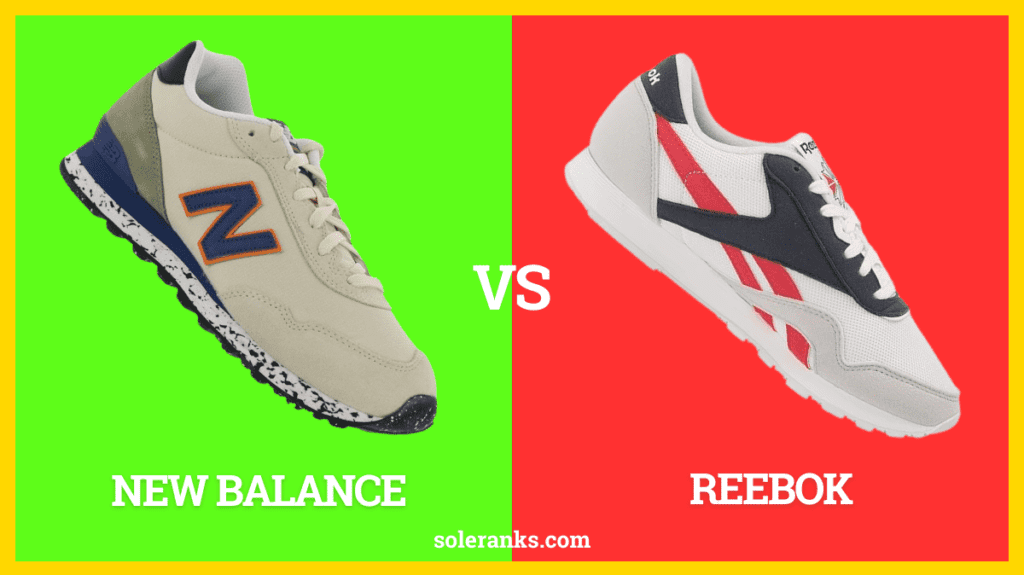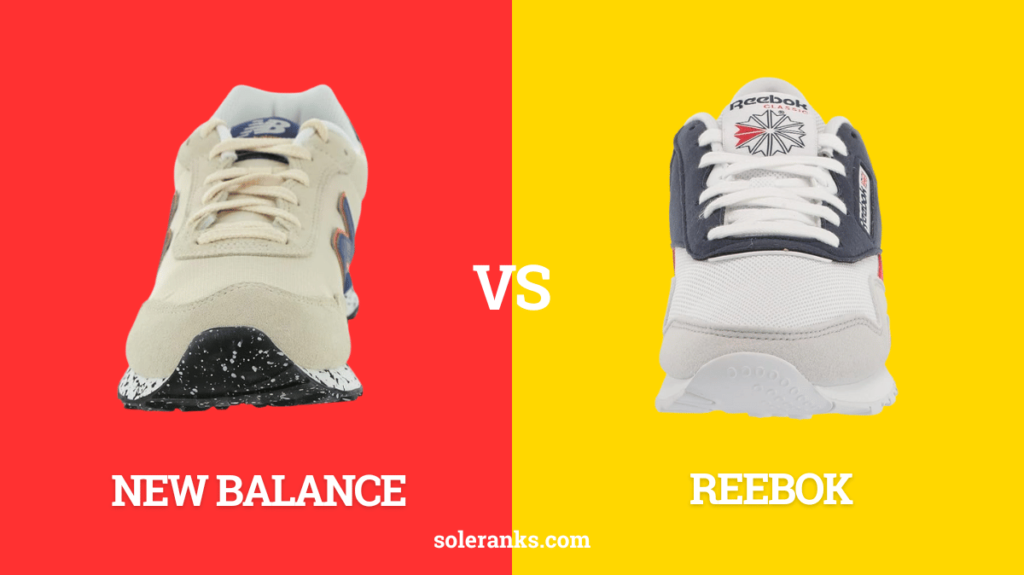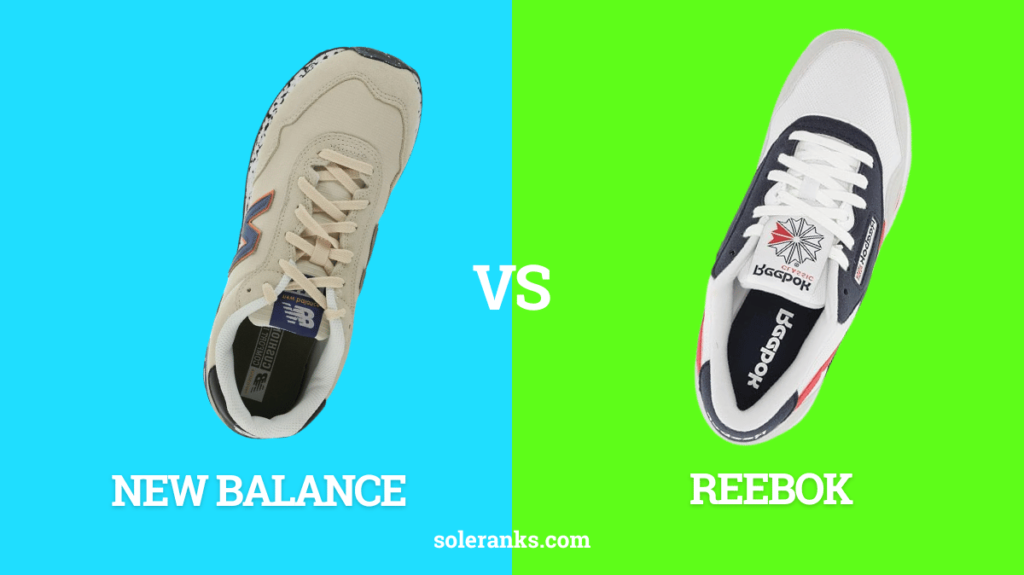New Balance shoes typically offer superior comfort with their plush cushioning and wider fit options, while Reebok excels in durability with their sturdy construction techniques.
Price-wise, New Balance tends to run slightly higher ($80-180) compared to Reebok ($60-150), reflecting their reputation for quality materials.
New Balance embraces classic, chunky athletic designs with their signature “N” logo, while Reebok offers more versatile lifestyle options with sleeker silhouettes.
For comfort and running performance, New Balance takes the lead for durability and everyday versatility at a lower price point, Reebok is the stronger contender.

Contents
- 1 New Balance vs Reebok Shoes
- 2 The History of New Balance and Reebok
- 3 Durability: Which Shoes Last Longer?
- 4 Breathability: Keeping Your Feet Cool
- 5 Cushioning: How They Feel When You Walk
- 6 Shoe Fit: Finding Your Perfect Size
- 7 Stability: Keeping You Steady on Your Feet
- 8 Comfort: How They Feel All Day Long
- 9 Quality: How Well They’re Made
- 10 Style: Looking Cool While Staying Comfortable
- 11 Size Range: Finding Shoes That Fit You
- 12 Materials: What Are They Made Of?
- 13 Weight: How Heavy They Feel On Your Feet
- 14 Flexibility: How They Bend With Your Foot
- 15 Water Resistance: Keeping Your Feet Dry
- 16 Sole: What’s On The Bottom Of The Shoe
- 17 User Reviews and Ratings
- 18 Price Comparison
- 19 Pros and Cons
- 20 Conclusion
- 21 Frequently Asked Questions
New Balance vs Reebok Shoes
New Balance and Reebok shoes is their design approach. New Balance focuses on stability and support with wider width options and technical features, while Reebok emphasizes style, flexibility and lightweight performance with sleeker designs for fitness activities and casual wear.
A Detailed Comparison Table: Finding the Best Choice for Your Comfort and Needs!
| Feature | New Balance | Reebok |
|---|---|---|
| Brand Origin | American (founded 1906) | British (founded 1958) |
| Width Options | Multiple widths (narrow, standard, wide, extra wide) | Mostly standard width, some wide options |
| Style | Classic, chunky, retro designs with “N” logo | Mix of retro classics and modern athletic designs |
| Cushioning Feel | Plush, soft cushioning (Fresh Foam, ENCAP) | Responsive, firmer cushioning (Floatride, Memory Tech) |
| Best For | Running, walking, all-day comfort | Training, gym workouts, retro fashion |
| Price Range | $50-$150, slightly higher on average | $45-$130, slightly lower on average |
| Fit | Roomier toe box, more accommodating | Medium width with secure heel fit |
| Special Features | Made in USA options, focus on support | CrossFit-specific models, retro collections |
| Parent Company | Independent | Owned by Adidas since 2005 |
| Athletic Focus | Running, walking, general athletics | Fitness training, CrossFit, basketball heritage |
| Durability | Excellent, built to last | Very good to excellent |
| Collaborations | Fewer special editions | Many pop culture collaborations (movies, games) |
| Target Audience | Support and comfort-focused | Training and fashion-focused |
| Size Range | Extensive, including hard-to-find sizes | Good, but fewer specialty sizes |
| Flexibility | Good, especially in running models | Excellent, especially in training models |
In summary: New Balance and Reebok both make quality athletic shoes but with different strengths. New Balance offers better width options, softer cushioning, and more support for running and walking with a focus on all-day comfort.
Reebok excels in training shoes with better flexibility, has more retro and special edition designs, and generally costs a bit less. New Balance is better for people who need specific widths, while Reebok is ideal for gym activities and fashion-forward styles.
People Also Like:
New Balance vs Skechers
The History of New Balance and Reebok
New Balance History
New Balance was started in 1906 in Boston, Massachusetts. A man named William J. Riley founded the company to make special arch supports to help people with foot problems. Later, they started making running shoes. New Balance became famous for making shoes in different widths, which helps more people find the perfect fit.
Today, New Balance is known for making comfortable, supportive shoes that last a long time. They still make some of their shoes in the United States, which is pretty special!
Reebok History
Reebok has an interesting history too! It was started in 1958 in the United Kingdom by two brothers named Joe and Jeff Foster. They named their company after an African gazelle called the “rhebok.” Reebok became super popular in the 1980s with their fitness and aerobic shoes.
In 2005, Reebok was bought by Adidas, another big shoe company. Today, Reebok makes all kinds of shoes for sports, fitness, and everyday wear. They’re especially known for their CrossFit and training shoes.
Durability: Which Shoes Last Longer?
New Balance Durability
New Balance shoes are known for being really tough! They use strong materials and solid construction that helps their shoes last a long time. The stitching is usually very secure, and the soles are made to handle lots of activity without wearing down quickly.
Many kids who wear New Balance find that their shoes still look good even after months of playing sports, running around at recess, and everyday walking. The company tests their shoes a lot to make sure they won’t fall apart easily.
Reebok Durability
Reebok also makes durable shoes, especially their training and running models. They use tough rubber for their soles and strong materials for the upper parts of the shoe. Reebok’s training shoes are designed to handle tough workouts, so they’re built to last.
For normal everyday use, both brands make shoes that will last you a good while. If you’re really tough on your shoes or wear them every day for sports, New Balance might have a slight edge in durability, but both brands make sturdy shoes.
Breathability: Keeping Your Feet Cool
New Balance Breathability
Nobody wants hot, sweaty feet! New Balance understands this and makes many of their shoes with special mesh materials that let air flow through. This helps keep your feet cool and dry, even when you’re active all day.
Many New Balance shoes have tiny holes or mesh panels on the top and sides. These let hot air escape and fresh air come in, which helps prevent stinky shoes!
Reebok Breathability
Reebok also focuses on making breathable shoes. Many of their athletic models use mesh uppers and special fabric technologies designed to keep your feet cool. Their training shoes especially need good airflow since workouts can make your feet sweat a lot.
Both brands offer shoes with good breathability, but if you have particularly sweaty feet or live somewhere very hot, look for models with lots of mesh in the upper part of the shoe.
People Also Like:
New Balance vs Orthofeet
Cushioning: How They Feel When You Walk
New Balance Cushioning
New Balance is famous for their cushioning technologies. They use special foam called “Fresh Foam” or “ENCAP” that feels super soft and bouncy under your feet! This cushioning helps protect your feet when you jump, run, or walk on hard surfaces.
The cushioning in New Balance shoes is especially good for kids who play sports or have to stand a lot during the day. It helps prevent tired, achy feet.
Reebok Cushioning
Reebok has its own cushioning technologies too! They use systems called “Floatride Energy” and “Memory Tech” that provide soft, responsive cushioning. Reebok’s cushioning tends to be a bit firmer compared to New Balance, which some people prefer for certain activities like gym workouts.
If you like a shoe that feels really soft and plush, you might prefer New Balance. If you want something that feels more supportive and stable, Reebok might be better for you.
Shoe Fit: Finding Your Perfect Size
New Balance Fit
One really cool thing about New Balance is that they make shoes in different widths. This is super helpful because not everyone’s feet are the same width! They offer narrow, standard, wide, and extra-wide options in many of their styles.
New Balance shoes tend to have a roomier toe box, which means there’s more space for your toes to spread out naturally. This can make them more comfortable for growing feet or if your feet are a bit wider.
Reebok Fit
Reebok shoes usually come in standard widths, though some models offer wide options too. They tend to have a medium width that works well for most people. Some Reebok shoes have a narrower fit, especially around the heel, which can be good for keeping your foot secure during workouts.
If you have wider feet, New Balance might be more comfortable for you. If you have narrow or average-width feet, Reebok might fit just right.

Stability: Keeping You Steady on Your Feet
New Balance Stability
Stability in shoes helps prevent your ankles from rolling inward or outward too much. New Balance designs many of their shoes with special support features that keep your foot aligned properly.
Many New Balance shoes have a firm heel counter (the back part of the shoe) and supportive midsole that work together to keep your foot stable. This is especially important when you’re running, jumping, or changing direction quickly during sports.
Reebok Stability
Reebok also makes shoes with good stability features, particularly in their training models. Reebok’s training shoes are designed for movements in all directions, so they need to keep your feet stable and supported.
For most activities, both brands provide enough stability to help prevent injuries. But if you need extra stability, look for shoes specifically designed for stability in either brand.
People Also Like:
New Balance vs On Cloud
Comfort: How They Feel All Day Long
New Balance Comfort
Comfort is a top priority for New Balance. Besides cushioning, they focus on making shoes that feel good from the first time you put them on. Many New Balance shoes don’t need a “break-in period” – they feel comfortable right away!
New Balance uses soft linings inside their shoes and padding around the ankle collar to prevent blisters and irritation. The multiple width options also help make sure you get a comfortable fit.
Reebok Comfort
Reebok also makes comfortable shoes. Their Memory Tech foam insoles mold to the shape of your foot for personalized comfort. Reebok shoes often have good padding in the tongue and collar to prevent rubbing and irritation.
Both brands make comfortable shoes, but New Balance might have a slight edge for all-day comfort, especially if you have wider feet or need more arch support.
Quality: How Well They’re Made
New Balance Quality
New Balance has been making shoes for a very long time, and they’ve gotten really good at it! They pay attention to small details like even stitching, secure gluing, and durable materials.
The quality control for New Balance shoes is very strict. Some New Balance shoes are even made in the United States or the United Kingdom, where they have close control over the manufacturing process.
Reebok Quality
Reebok also makes quality shoes with good attention to detail. Their sports performance shoes are especially well-made since athletes need reliable footwear.
Both brands offer good quality shoes, though the most premium materials are usually found in the higher-priced models from both companies.
Style: Looking Cool While Staying Comfortable
New Balance Style
New Balance has a style that’s a mix of sporty and classic. Their shoes often have a chunky, retro look that has become very popular in fashion recently. They offer lots of color options, from simple white, black, and gray to brighter colors like blue, red, and green.
New Balance shoes are great for everyday wear and can go with lots of different outfits. They’re not as flashy as some other brands, which some kids like because they’re more versatile.
Reebok Style
Reebok has a mix of retro and modern styles. Their classic shoes like the Club C and Classic Leather have a cool vintage look that many kids love. Reebok also makes more modern-looking athletic shoes for different sports and activities.
Reebok often partners with movies, video games, and celebrities to create special edition shoes with unique designs. If you want shoes that make a statement or show off your interests, Reebok might have more options.
Size Range: Finding Shoes That Fit You
New Balance Size Range
New Balance offers one of the widest size ranges of any shoe company. They make kids’ shoes starting at very small sizes for toddlers all the way up to big adult sizes. This makes them great for growing feet!
As mentioned earlier, they also offer multiple width options, which can be really helpful if you have narrow or wide feet.
Reebok Size Range
Reebok offers a good range of sizes too, including kids’ sizes. However, they don’t offer as many width options as New Balance, mostly sticking to standard widths with some models available in wide.
If you need special sizes or widths, New Balance might be the better choice for you.

Materials: What Are They Made Of?
New Balance Materials
New Balance uses a variety of materials in their shoes:
- Mesh fabric for breathability
- Synthetic leather for structure and support
- Foam for cushioning
- Rubber for durable outsoles
- Suede for some lifestyle models
They choose materials based on what each shoe is designed for. Running shoes use more mesh for breathability, while casual shoes might use more suede or leather-like materials.
Reebok Materials
Reebok also uses a mix of materials:
- Mesh and knit fabrics for breathability
- Synthetic and real leather for some models
- Foam cushioning
- Rubber for outsoles
- Special flexible materials for training shoes
Reebok sometimes uses innovative materials, especially in their performance training shoes that need to be both tough and flexible.
People Also Like:
New Balance vs Ryka
Weight: How Heavy They Feel On Your Feet
New Balance Weight
New Balance makes shoes in a range of weights. Their running and athletic shoes tend to be lightweight to help you move faster. Their casual shoes and those designed for extra support might be a bit heavier.
For kids, New Balance generally tries to keep the weight down since heavy shoes can be tiring to wear all day.
Reebok Weight
Reebok shoes also come in different weights depending on their purpose. Their running shoes are typically lightweight, while their classic lifestyle shoes might be a bit heavier.
If having very lightweight shoes is important to you, both brands offer lightweight options, especially in their running and athletic collections.
Flexibility: How They Bend With Your Foot
New Balance Flexibility
Flexibility is important because your foot needs to bend naturally when you walk and run. New Balance designs their shoes with flex grooves in the sole that allow the shoe to bend where your foot naturally bends.
Different New Balance models offer different levels of flexibility based on their intended use. Running shoes tend to be more flexible, while shoes for sports like basketball might be a bit stiffer for support.
Reebok Flexibility
Reebok shoes are often designed to be very flexible, especially their training shoes. Many Reebok shoes have special flex grooves and cuts in the sole to allow natural movement in all directions.
If you need shoes that can bend and flex a lot, especially for activities like dance or gym class, Reebok’s training shoes might have an advantage in flexibility.
Water Resistance: Keeping Your Feet Dry
New Balance Water Resistance
Most standard New Balance shoes aren’t fully waterproof, but many have water-resistant features that help keep your feet dry in light rain or wet grass. They use materials that don’t soak up water easily and designs that keep water from getting inside the shoe.
New Balance does make some fully waterproof shoes, but these are usually specialized models for hiking or outdoor activities.
Reebok Water Resistance
Like New Balance, most regular Reebok shoes aren’t completely waterproof, but they do offer some resistance to light moisture. Reebok also makes some special waterproof models for outdoor activities.
If keeping your feet dry in wet conditions is really important to you, look for shoes from either brand that specifically mention water resistance in their description.
People Also Like:
New Balance vs Reebook
Sole: What’s On The Bottom Of The Shoe
New Balance Soles
New Balance uses durable rubber for their outsoles (the bottom part that touches the ground). They design different tread patterns for different activities:
- Running shoes have flexible grooves and cushioning
- Training shoes have flat, stable soles for gym activities
- Casual shoes have smoother soles for everyday wear
The soles are designed to provide good grip on different surfaces while lasting a long time without wearing down.
Reebok Soles
Reebok also uses rubber for their outsoles, with special patterns designed for different activities. Their training shoes often have multi-directional patterns for grip when moving in any direction. Many Reebok shoes use high-abrasion rubber in areas that wear down quickly to make them last longer.
Both brands provide good grip and durability in their soles, though the specific patterns and designs vary based on the shoe’s purpose.

User Reviews and Ratings
| Shoe Model | Overall Rating | Comfort | Durability | Style | User Comments |
|---|---|---|---|---|---|
| New Balance 574 | ⭐⭐⭐⭐⭐ | ⭐⭐⭐⭐⭐ | ⭐⭐⭐⭐☆ | ⭐⭐⭐⭐☆ | “Super comfortable for all-day wear. My feet never hurt even after walking all day at school.” |
| Reebok Classic Leather | ⭐⭐⭐⭐☆ | ⭐⭐⭐⭐☆ | ⭐⭐⭐⭐⭐ | ⭐⭐⭐⭐⭐ | “These look so cool with everything I wear! Plus they’re really durable and don’t get dirty easily.” |
| New Balance Fresh Foam | ⭐⭐⭐⭐⭐ | ⭐⭐⭐⭐⭐ | ⭐⭐⭐⭐☆ | ⭐⭐⭐☆☆ | “Best cushioning ever! Like walking on clouds, perfect for running.” |
| Reebok Nano | ⭐⭐⭐⭐☆ | ⭐⭐⭐☆☆ | ⭐⭐⭐⭐⭐ | ⭐⭐⭐⭐☆ | “Great for gym class and sports. Super tough and grippy on all surfaces.” |
Price Comparison
| Shoe Type | New Balance Price | Reebok Price | Best For |
|---|---|---|---|
| Basic Casual Shoes | $50-$70 | $45-$65 | Everyday wear, school |
| Athletic Running Shoes | $80-$120 | $70-$100 | Sports, running |
| Training/Gym Shoes | $90-$130 | $80-$120 | Gym class, workouts |
| Limited Edition/Fashion | $100-$150 | $90-$130 | Style, collecting |
Pros and Cons
New Balance Shoes
| Pros ✅ | Cons ⚠️ |
|---|---|
| Come in many different widths for all foot types | Usually cost a bit more money than Reebok |
| Super soft cushioning feels like walking on clouds | Not as many cool special editions with movies or games |
| Great for people with wide feet | Can look chunky or “dad shoe” style |
| Very durable and last a long time | Not as flexible for gym activities |
| Perfect for running and walking | Not as many bright, flashy colors |
| Excellent for all-day comfort | Can be heavier than some Reebok shoes |
| Good arch support for flat feet | Less popular for training and gym class |
| Some are made in the USA | Design doesn’t change much between models |
Reebok Shoes
| Pros ✅ | Cons ⚠️ |
|---|---|
| Usually less expensive than New Balance | Don’t come in as many width options |
| Great for gym class and sports training | Not as good for people with wide feet |
| Very flexible for different movements | Cushioning isn’t as soft and plush |
| Many cool special editions with movies and games | Not as much arch support |
| Lighter weight for most models | Fewer options for running shoes |
| Modern, stylish designs | Standard width might feel tight for some kids |
| Good grip for gym floors and playing fields | Not as much selection of sizes |
| Retro classics that look cool with jeans | Some models aren’t as durable for everyday wear |
Conclusion
After looking at all these features, which shoe brand is best for you? Here’s what I think:
Choose New Balance if:
- You need special sizes or widths (especially wide feet)
- You want the most comfortable cushioning for all-day wear
- You prefer a classic, chunky style
- You need extra support or stability for your feet
- You want shoes that will last as long as possible
Choose Reebok if:
- You do lots of different sports and activities
- You want shoes with a cool retro vibe
- You need very flexible shoes for training
- You like shoes with special edition designs (like video game or movie themes)
- You’re looking for slightly lower prices
Both New Balance and Reebok make great shoes that kids love. The main differences come down to fit, style, and the specific features that matter most to you. New Balance might be better for comfort and support, while Reebok might win for training activities and cool special editions.
Remember, the best shoe is the one that fits YOUR feet and YOUR needs the best!
Frequently Asked Questions
Which brand lasts longer, New Balance or Reebok?
Most kids find that both brands last about the same amount of time with normal wear. New Balance might have a slight edge for everyday durability, while Reebok training shoes are built to handle tough workouts.
Are New Balance or Reebok shoes better for sports?
Both brands make good sports shoes! New Balance tends to excel in running shoes, while Reebok makes great training shoes for activities like gym class, CrossFit, and other sports that need lots of different movements.
Which brand is more popular at school?
This changes all the time! Right now, both brands are popular with kids. New Balance has a cool “dad shoe” look that many kids like, while Reebok has both retro classics and modern athletic styles that are popular.
How do I know what size to buy?
Try to measure your foot or try the shoes on in a store first. New Balance tends to run true to size or slightly large, while Reebok usually runs true to size. When in doubt, read the reviews for that specific shoe model.
Are these shoes good for kids with foot problems?
New Balance is often recommended by doctors for kids with foot issues because of their supportive designs and multiple width options. Reebok can work well too, but they have fewer options for kids with special foot needs.
How do I clean my shoes?
For both brands, use a soft brush to remove dirt, then wipe with a damp cloth and mild soap. Let them air dry away from direct heat or sunlight. Never put them in the washing machine or dryer!
Which brand is more expensive?
On average, the prices are similar, but New Balance tends to be slightly more expensive than Reebok for comparable models. Both brands have shoes at different price points, from budget-friendly to premium options
